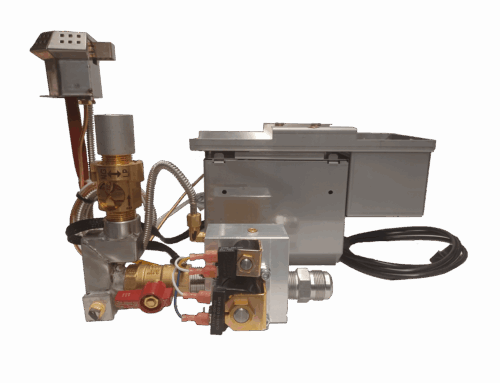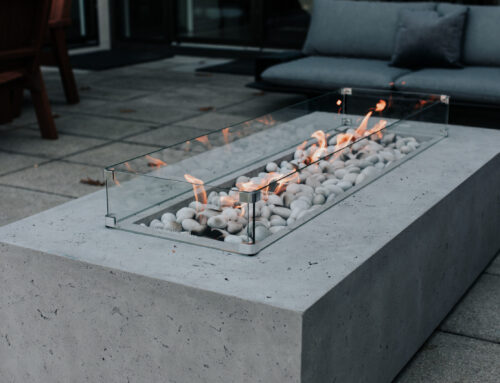
At HPC Fire Inspired, we often discuss the differences between natural gas and liquid propane (LP) fire pits and their impact on the operation, installation, and performance of our fire features. In this article, we’ll explore the unique properties and considerations of each fuel type, covering key topics like chemical composition, energy content, and safety.
Chemical Composition and Characteristics
When comparing natural gas and liquid propane, it’s essential to understand their distinct chemical compositions, physical properties, and practical applications. Both are popular fuel sources used in residential, industrial, and commercial settings, yet they differ significantly in molecular structure, energy content, and storage needs.
Natural Gas: Primarily composed of methane (CH₄), natural gas is a lighter, colorless, highly flammable gas that is
transported through pipelines, making it widely accessible in urban areas.
Liquid Propane (LP): Propane (C₃H₈) is derived from petroleum refining and natural gas processing. It is stored as a pressurized liquid and commonly used in areas without pipeline access. Propane gas lends itself for portable applications.
By examining the difference between the compositions and characteristics of both Natural Gas and Liquid Propane, we can identify which fuel might be most suitable for different applications.
Composition: Molecules and Energy Content

1 carbon atom & 4 hydrogen atoms 3 carbon atoms & 8 hydrogen molecule
Propane contains more carbon and hydrogen atoms than natural gas. This additional hydrogen and carbon provide propane with a higher energy content per cubic foot of gas, enabling it to release more energy when burned. The composition of Natural Gas allows it to burn clean making it a more environmentally friendly option.
Specific Gravity
Specific gravity is the density of a gas relative to air, which has a specific gravity of 1.0.
Natural Gas has a specific gravity of approximately 0.6, meaning it is lighter than air. When Natural Gas is released it rises allowing it to dissipate quickly.
Propane has a specific gravity of 1.52, making it heavier than air. This causes propane to sink and accumulate in low areas, taking longer to dissipate than natural gas.
These properties are crucial for safety considerations, as they affect how each gas behaves when released into the atmosphere. This difference also impacts orifice sizing and burner ratings in engineering.
Ignition Temperatures
Ignition temperature is the lowest temperature at which a substance can ignite and sustain combustion without an external flame or spark. Understanding these temperatures helps ensure safe handling and system design.
Propane: Ignites between 920°F and 1,120°F.
Natural Gas: Requires a slightly higher ignition temperature, around 1,150°F.
This difference allows propane to ignite from a smaller, more distant heat source, informing design choices in igniters and flame-sensing safety features for HPC Fire Inspired fire pits.
Combustion Ratio
The combustion ratio refers to the volume of air required for the complete combustion of a fuel.
Natural Gas: Requires 10 cubic feet of air per cubic foot of gas (10:1 ratio).
Propane: Needs 24 cubic feet of air per cubic foot of gas (24:1 ratio).
Propane’s higher combustion ratio is due to its higher energy content and additional carbon and hydrogen atoms. To burn propane safely, it requires careful engineering of air mixers and air shutters to provide adequate primary air for combustion.
Heat Value
Heat value measures the energy released when a fuel is completely burned, commonly expressed in BTUs (British Thermal Units).
Propane: Yields approximately 2,500 BTUs per cubic foot (91,500 BTUs per gallon).
Natural Gas: Produces about 1,000 BTUs per cubic foot.
Due to propane’s higher heat output, smaller burner orifices can be used to achieve the same flame height and warmth as a natural gas setup, which requires a larger orifice to compensate for its lower heat value per cubic foot.
In summary, understanding the distinct technical characteristics of natural gas and propane allows us to make informed decisions for HPC Fire Inspired products, optimizing performance, efficiency, and safety in every fire feature. By tailoring design elements to the fuel type, we can ensure an enhanced and reliable user experience.
If you have any questions or concerns, please give us a call at 937-436-9800. Let our NFI certified technicians provide guidance around all your fire design needs.
Looking to learn more about HPC’s Offerings? Schedule an online or in person training with Chuck Parsons, HPC’s training and education manager.





